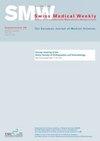Glycaemic outcomes in adults with type 1 diabetes transitioning towards advanced automated insulin delivery systems – a real-world analysis at a Swiss tertiary centre
IF 2.1
4区 医学
Q2 MEDICINE, GENERAL & INTERNAL
引用次数: 0
Abstract
AIMS OF THE STUDY: To assess glucose levels in adults with diabetes at a Swiss tertiary hospital when transitioning from insulin delivery with a sensor-augmented pump with (predictive) low-glucose suspend ([P]LGS) to a hybrid-closed loop (HCL) and from a HCL to an advanced hybrid-closed loop (AHCL). METHODS: Continuous glucose monitoring data for 44 adults with type 1 diabetes transitioning from (P)LGS to hybrid-closed loop and from hybrid-closed loop to advanced hybrid-closed loop were analysed, including the percentage of time spent within, below, and above glucose ranges. In addition, a subgroup analysis (n = 14) of individuals undergoing both transitions was performed. RESULTS: The transition from a (P)LGS to a hybrid-closed loop was associated with increased time in range (6.6% [2.6%–12.7%], p <0.001) and decreased time above range (5.6% [2.3%–12.7%], p <0.001). The transition from a hybrid-closed loop to an advanced hybrid-closed loop was associated with increased time in range (1.6% [−0.5%–4.5%], p = 0.046) and decreased time above range (1.5% [–1.8%–5.6%], p = 0.050). Both transitions did not change the time below range. In the subgroup analysis ([P]LGS → HCL → AHCL), the time in range increased from 69.4% (50.3%–79.2%) to 76.5% (65.3%–81.3%) and 78.7% (69.7%–85.8%), respectively (p <0.001). CONCLUSIONS: Glucose levels significantly improved when transitioning from a (P)LGS to a hybrid-closed loop. Glucose levels improved further when switching from a hybrid-closed loop to an advanced hybrid-closed loop. However, the added benefit of an advanced hybrid-closed loop was comparably smaller. This pattern was also reflected in the subgroup analysis.向先进的胰岛素自动给药系统过渡的成人 1 型糖尿病患者的血糖结果--瑞士一家三级医疗中心的实际情况分析
研究目的:评估瑞士一家三甲医院成年糖尿病患者从使用带(预测性)低血糖暂停([P]LGS)的传感器增强泵输送胰岛素过渡到混合闭环(HCL)以及从混合闭环过渡到高级混合闭环(AHCL)时的血糖水平。方法:分析了 44 名成年 1 型糖尿病患者从 (P)LGS 过渡到混合闭环以及从混合闭环过渡到高级混合闭环的连续葡萄糖监测数据,包括在血糖范围内、低于血糖范围和高于血糖范围所花费的时间百分比。结果:从 (P)LGS 过渡到混合闭环与在血糖范围内的时间增加(6.6% [2.6%-12.7%],P <0.001)和在血糖范围以上的时间减少(5.6% [2.3%-12.7%],P <0.001)有关。从混合闭环过渡到高级混合闭环与范围内时间增加(1.6% [-0.5%-4.5%],p = 0.046)和范围以上时间减少(1.5% [-1.8%-5.6%],p = 0.050)有关。两种转变均未改变低于范围的时间。在亚组分析中([P]LGS → HCL → AHCL),在范围内的时间分别从 69.4% (50.3%-79.2%) 增加到 76.5% (65.3%-81.3%) 和 78.7% (69.7%-85.8%) (p <0.001):从 (P)LGS 过渡到混合闭环后,血糖水平明显改善。从混合闭环转换到高级混合闭环后,血糖水平进一步提高。然而,高级混合闭环的额外益处相对较小。这种模式也反映在亚组分析中。
本文章由计算机程序翻译,如有差异,请以英文原文为准。
求助全文
约1分钟内获得全文
求助全文
来源期刊

Swiss medical weekly
医学-医学:内科
CiteScore
5.00
自引率
0.00%
发文量
0
审稿时长
3-8 weeks
期刊介绍:
The Swiss Medical Weekly accepts for consideration original and review articles from all fields of medicine. The quality of SMW publications is guaranteed by a consistent policy of rigorous single-blind peer review. All editorial decisions are made by research-active academics.
 求助内容:
求助内容: 应助结果提醒方式:
应助结果提醒方式:


